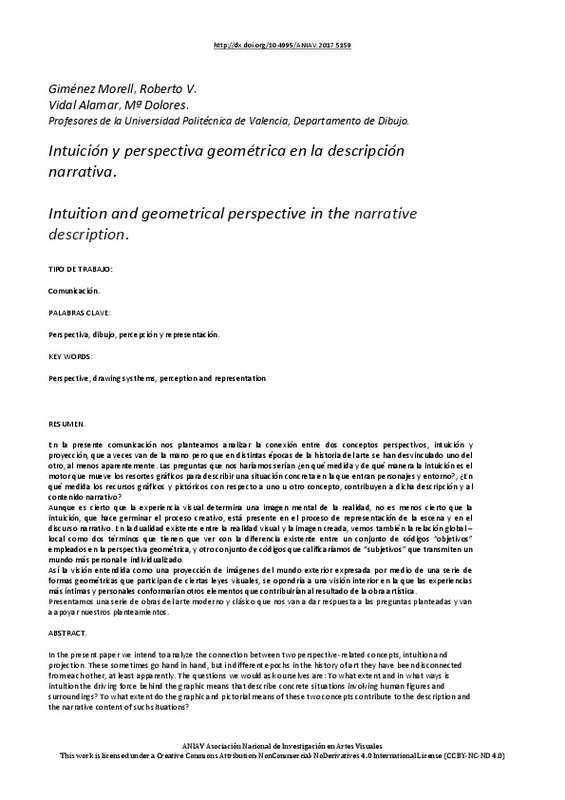JavaScript is disabled for your browser. Some features of this site may not work without it.
Buscar en RiuNet
Listar
Mi cuenta
Estadísticas
Ayuda RiuNet
Admin. UPV
Intuición y perspectiva geométrica en la descripción narrativa
Mostrar el registro sencillo del ítem
Ficheros en el ítem
| dc.contributor.author | Vidal Alamar, Mª Dolores
|
es_ES |
| dc.contributor.author | Giménez Morell, Roberto Vicente
|
es_ES |
| dc.date.accessioned | 2018-09-07T09:23:33Z | |
| dc.date.available | 2018-09-07T09:23:33Z | |
| dc.date.issued | 2017-10-23 | |
| dc.identifier.isbn | 9788490485736 | |
| dc.identifier.uri | http://hdl.handle.net/10251/106769 | |
| dc.description.abstract | [EN] In the present paper we intend to analyze the connection between two perspectivebrelated concepts, intuition and projection. These sometimes go hand in hand, but in different epochs in the history of art they have been disconnected from each other, at least apparently. The questions we would ask ourselves are: To what extent and in what ways is intuition the driving force behind the graphic means that describe concrete situations involving human figures and surroundings? To what extent do the graphic and pictorial means of these two concepts contribute to the description and the narrative content of such situations? Although it is true that visual experience determines a mental image of reality, it is also true that intuition is the seed of the creative process, and it is present in the process of representation of the scene and in the narrative discourse. In the duality between reality and the image produced, we also see the globalblocal relationship of the two terms, and the difference between a set of "objective" codes, used in geometric perspective, and another set of "subjective" codes, which convey a more personal and individualized world. Thus the vision understood as a projection of images of the external world, expressed through a series of geometric forms that involve certain visual laws, would oppose an inner vision in which the more intimate and personal experiences would conform to other elements that would contribute to the result of the artistic work. We show several paintings of modern and classic art to answer the previous questions and to support our proposals. | es_ES |
| dc.description.abstract | [ES] En la presente comunicación nos planteamos analizar la conexión entre dos conceptos perspectivos, intuición y proyección, que a veces van de la mano pero que en distintas épocas de la historia del arte se han desvinculado uno del otro, al menos aparentemente. Las preguntas que nos haríamos serían ¿en qué medida y de qué manera la intuición es el motor que mueve los resortes gráficos para describir una situación concreta en la que entran personajes y entorno?, ¿En qué medida los recursos gráficos y pictóricos con respecto a uno u otro concepto, contribuyen a dicha descripción y al contenido narrativo? Aunque es cierto que la experiencia visual determina una imagen mental de la realidad, no es menos cierto que la intuición, que hace germinar el proceso creativo, está presente en el proceso de representación de la escena y en el discurso narrativo. En la dualidad existente entre la realidad visual y la imagen creada, vemos también la relación global(–( local como dos términos que tienen que ver con la diferencia existente entre un conjunto de códigos “objetivos” empleados en la perspectiva geométrica, y otro conjunto de códigos que calificaríamos de “subjetivos” que transmiten un mundo más personal e individualizado. Así la visión entendida como una proyección de imágenes del mundo exterior expresada por medio de una serie de formas geométricas que participan de ciertas leyes visuales, se opondría a una visión interior en la que las experiencias más íntimas y personales conformarían otros elementos que contribuirían al resultado de la obra artística. Presentamos una serie de obras del arte moderno y clásico que nos van a dar respuesta a las preguntas planteadas y van a apoyar nuestros planteamientos. | es_ES |
| dc.format.extent | 6 | es_ES |
| dc.language | Español | es_ES |
| dc.publisher | Editorial Universitat Politècnica de València | es_ES |
| dc.relation.ispartof | Glocal [codificar, mediar, transformar, vivir] III Congreso Internacional de Investigación en Artes Visuales | es_ES |
| dc.rights | Reconocimiento - No comercial - Sin obra derivada (by-nc-nd) | es_ES |
| dc.subject | Perspectiva | es_ES |
| dc.subject | Dibujo | es_ES |
| dc.subject | Percepción y representación | es_ES |
| dc.subject | Perspective | es_ES |
| dc.subject | Drawing systhems | es_ES |
| dc.subject | Perception and representation | es_ES |
| dc.title | Intuición y perspectiva geométrica en la descripción narrativa | es_ES |
| dc.title.alternative | Intuition and geometrical perspective in the narrative description | es_ES |
| dc.type | Capítulo de libro | es_ES |
| dc.type | Comunicación en congreso | es_ES |
| dc.identifier.doi | 10.4995/ANIAV.2017.5159 | |
| dc.rights.accessRights | Abierto | es_ES |
| dc.contributor.affiliation | Universitat Politècnica de València. Departamento de Dibujo - Departament de Dibuix | es_ES |
| dc.contributor.affiliation | Universitat Politècnica de València. Facultad de Bellas Artes - Facultat de Belles Arts | es_ES |
| dc.description.bibliographicCitation | Vidal Alamar, MD.; Giménez Morell, RV. (2017). Intuición y perspectiva geométrica en la descripción narrativa. En Glocal [codificar, mediar, transformar, vivir] III Congreso Internacional de Investigación en Artes Visuales. Editorial Universitat Politècnica de València. 703-709. https://doi.org/10.4995/ANIAV.2017.5159 | es_ES |
| dc.description.accrualMethod | OCS | es_ES |
| dc.relation.conferencename | III Congreso Internacional de Investigación en Artes Visuales :: ANIAV 2017 :: GLOCAL | es_ES |
| dc.relation.conferencedate | Julio 06-07,2017 | es_ES |
| dc.relation.conferenceplace | Valencia, Spain | es_ES |
| dc.relation.publisherversion | http://ocs.editorial.upv.es/index.php/ANIAV/ANIAV2017/paper/view/5159 | es_ES |
| dc.description.upvformatpinicio | 703 | es_ES |
| dc.description.upvformatpfin | 709 | es_ES |
| dc.type.version | info:eu-repo/semantics/publishedVersion | es_ES |
| dc.relation.pasarela | OCS\5159 | es_ES |








